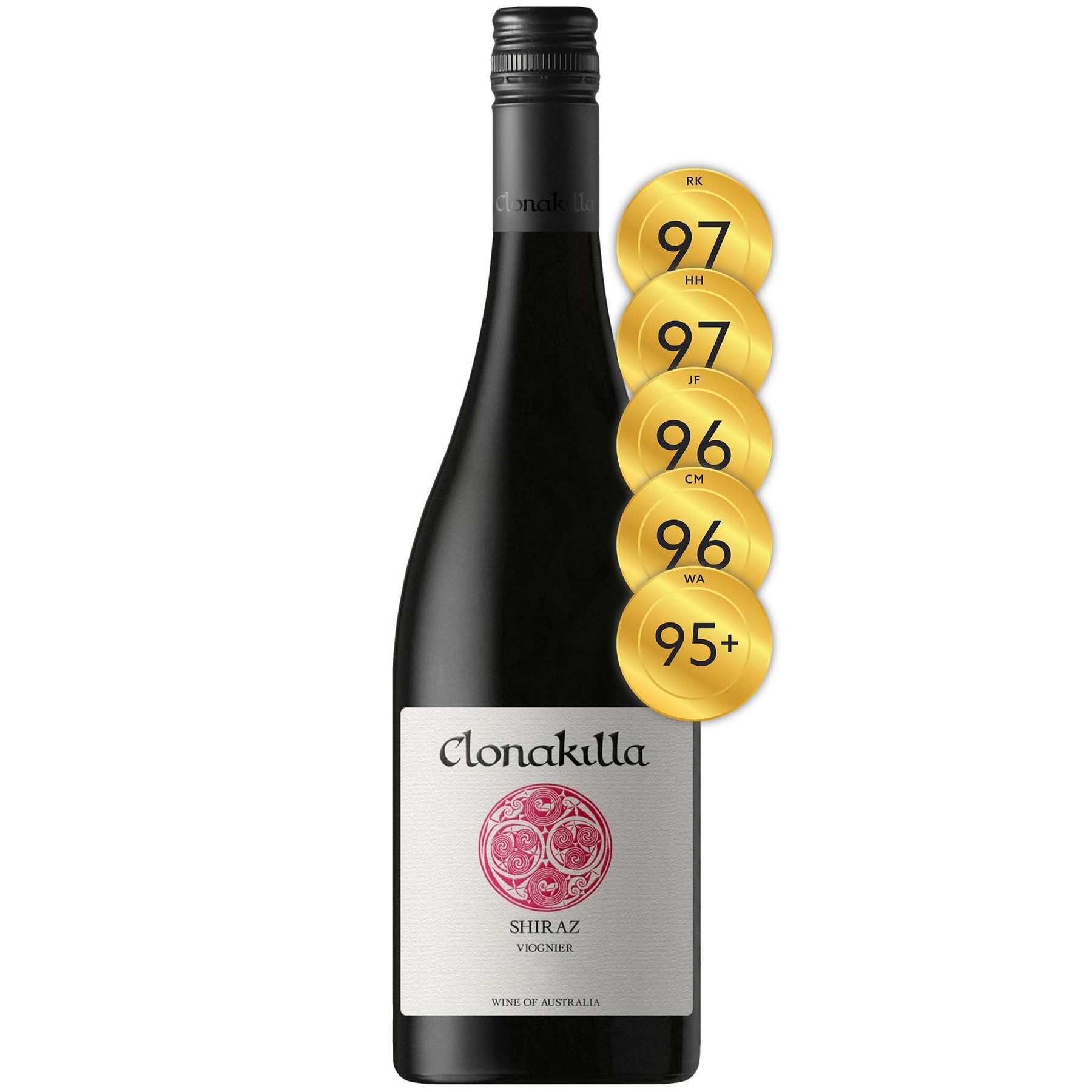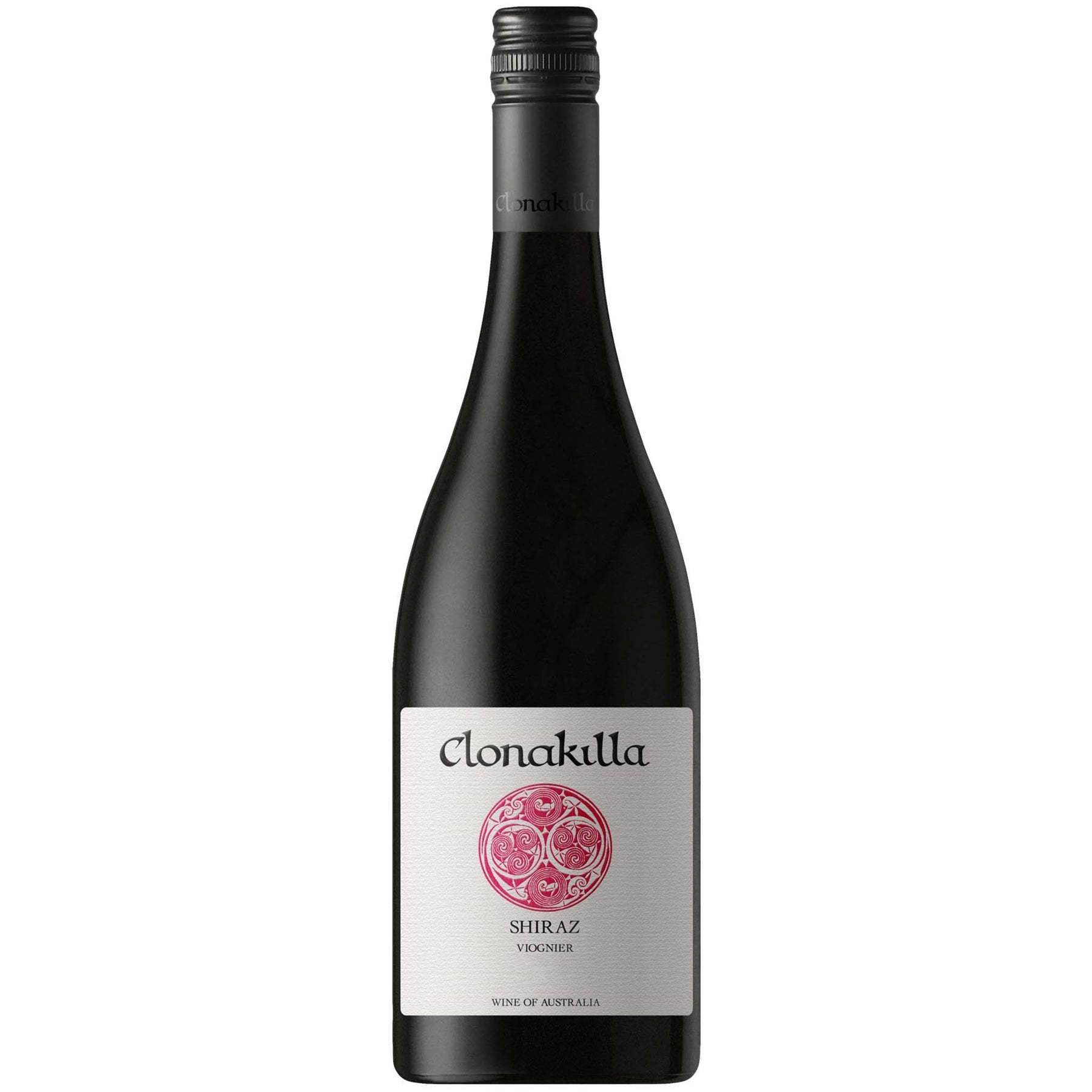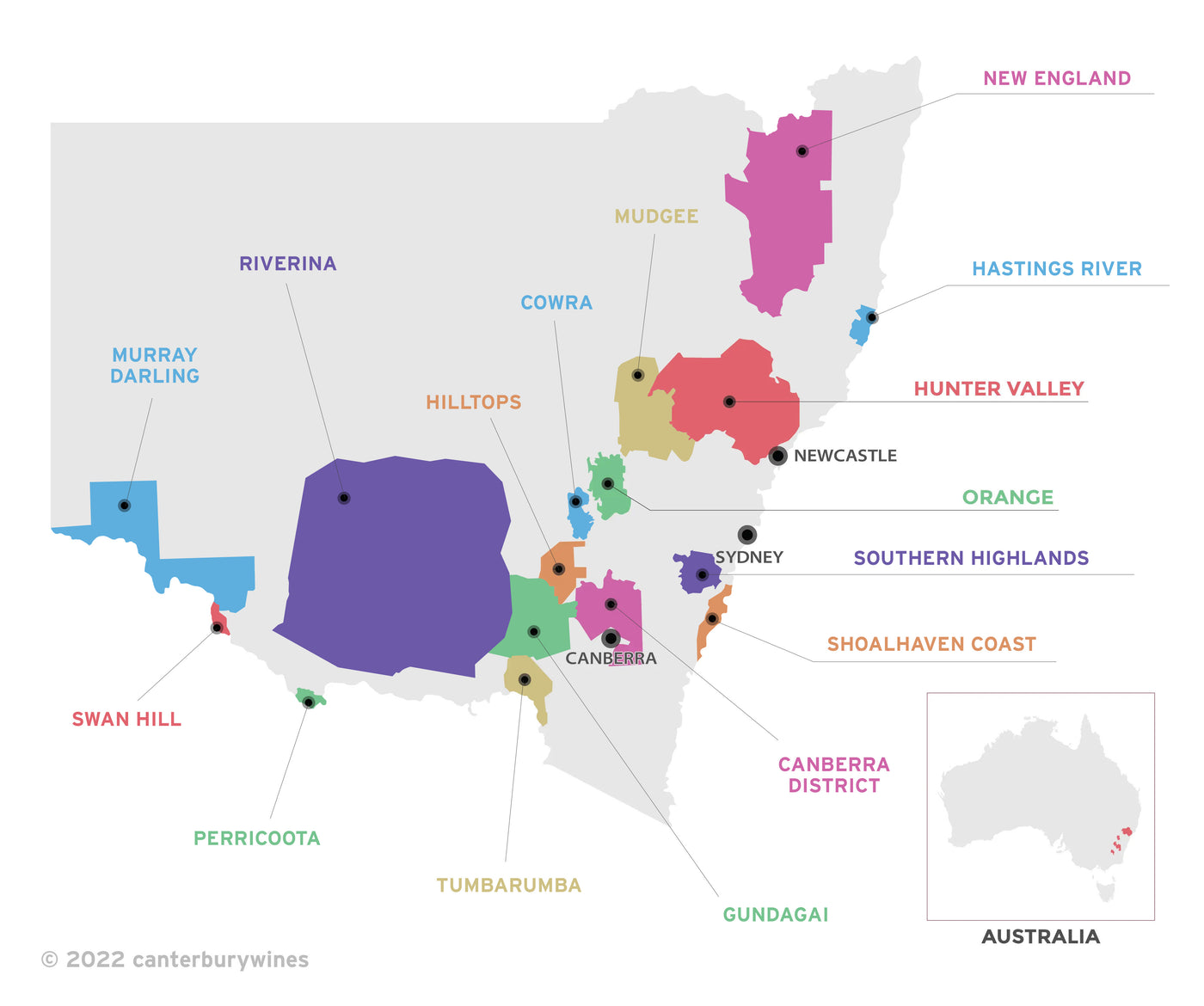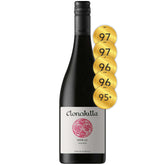

Clonakilla Shiraz Viognier 2019
Style: Red Wine
Closure: Screwcap
Clonakilla Shiraz Viognier 2019
Warehouse
34 Redland Drive
Vermont VIC 3133
Australia
Critic Score: 97
Alcohol: 14.0%
Size: 750 ml
Drink by: 2040
"It is one of our four greatest reds, alongside Penfold’s Grange, Henschke’s Hill of Grace and Cullen’s Diana Madeline Cabernet Sauvignon." Ken Gargett
Established in 1971, Clonakilla is a small family winery at Murrumbateman dedicated to producing distinctive, handcrafted Canberra region wines. The Clonakilla Shiraz Viognier, their flagship wine, draws its inspiration from the great wines of Côte-Rôtie and is a masterclass in cool-climate winemaking. It has won numerous awards and has been regularly nominated as Wine of the Year by Australia's leading Wine Critics. It is one of the great wines of Australia and is recognised as a world-class red in its own right.
"This is a wonderful release. It leaps from the glass with wonder on its lips. Plums and florals and spices and meats take a walk through a garden, woodsmoke suggested, summer alive. It’s elegant and refined and yet it’s all there, it’s all open. It gets you in the feels; it has a kind of satiny confidence, like it knows that it’s good and it knows that you’ve noticed. Fine fingers of tannin, curry leaf notes, berries. Florals here as mentioned but maybe not as pronounced as usual, as if viognier and shiraz have become one. Still there’s nothing reserved about this wine. Nothing. It’s just all there, ready, perfect." Campbell Mattinson
Winemaker Tim Kirk discusses the 2019 Shiraz Viognier
Expert reviews
"Deep, bright red/purple colour with a fragrant sweet-spice aroma, white pepper, cloves—an assortment of spices, nicely harmonised, nothing dominating too much. The wine is medium-bodied but very intense with a long carry, and firm, tightly-coiled tannins on the follow-through. A beautifully perfumed, harmonious, fine but intense wine. (6% co-fermented viognier. Yields were 20% reduced). Drink: 2021-2033." Huon Hooke, The Real Review - 97 points
"The just-released 2019 has lovely freshness and purity with crushed berry aromas, a musky floral thread, complexities of spice, dry herbs and understated smoky oak. It’s medium-bodied with a lovely silky texture, impressive intensity of lingering flavour and ripe, soft tannins in perfect harmony. Delicious right now as a young wine, but its potential with bottle age is proven by past experience. Drink: 2021-2031." Ralph Kyte-Powell, The Real Review - 97 points
"Some wines have such distinct DNA. This is one of them. It packs so many layers of flavour and depth, yet never moves much beyond medium body. It smells of a souk market; spicy, peppery and exotic. It's replete with dark fruit, wood char and a touch of wintergreen. Raw silk tannins matched to a neat acid line give freshness, vibrancy and a promise it will last some distance yet. Drink by 2035." Jane Faulkner, Halliday Wine Companion - 96 points
"It spent 18 months in oak, rather than it’s usual 12. Oak’s presence in the wine is no more than usual; if anything it simply feels more harmonious. In any case this is a wonderful release. It leaps from the glass with wonder on its lips. Plums and florals and spices and meats take a walk through a garden, woodsmoke suggested, summer alive. It’s elegant and refined and yet it’s all there, it’s all open. It gets you in the feels; it has a kind of satiny confidence, like it knows that it’s good and it knows that you’ve noticed. Fine fingers of tannin, curry leaf notes, berries. Florals here as mentioned but maybe not as pronounced as usual, as if viognier and shiraz have become one. Still there’s nothing reserved about this wine. Nothing. It’s just all there, ready, perfect. Drink: 2021-2040+". Campbell Mattinson, The Wine Front - 96 points
"The 2019 Shiraz Viognier is from a low-yielding (down around 15% to 20%), warm and dry year with some well-timed summer rain that allowed the vines to produce bright, lively fruit. The warm year brought higher alcohol with it (14.6% alcohol as opposed to the 13.2% of 2021), but the same 6% Viognier inclusion remains. The wine was matured for 18 months in French oak. Where the 2021 is bright, delicate and lacy, this 2019 is denser, muscular and layered with dark, brooding, exotic spices, cocoa nib, licorice root, roasted meat rind and tobacco leaf. In the mouth, the tannins are the most pertinent feature: still powdery fine and shapely, earthy (black) and savory. At no point does any feature of the wine break ranks. There are no strays, no breakaways; this is seamless and contained from all angles. It is an astounding wine and proof that very quickly after release these wines morph into shades of what they will become in older age. Drink: 2022-2039." Erin Larkin, The Wine Advocate - 95+ points (Tasted Nov 2022)
About the winemaker

"As humans go, Tim Kirk is a good one; he is courteous and respectful, is generous with his time and when you talk to him, he genuinely listens. That, and he also makes very, very good wine. On a personal level, he is deeply spiritual. He doesn't hide his faith but is far from preachy. It's a pure, inclusive belief and he radiates a quiet, confident and contented joy. He's like a six-foot scholarly Friar Tuck who, instead of mead, makes Australia's best Shiraz Viognier." Wine Selectors
In 1991 Tim Kirk travelled to the Rhône Valley where he tasted the great Shiraz-based wines of Côte-Rôtie and Hermitage. The highlight of the trip was at the Guigal family winery, where Tim tasted the 1988 single vineyard Côte-Rôties La Landonne, La Mouline and La Turque from barrel.
This was a turning point. Tim remembers it well: "There are rare moments in a wine lover's life when you find yourself transfixed by the extraordinary beauty of what's in the glass before you, and tasting those Cote Roties was just such a revelatory moment for me. They had striking aromas; an ethereal perfume with complex, savoury dimensions, while the palate structure was different to the robust texture that Australian Shiraz wines are renowned for. These wines were finer in texture, the tannins leaving a silky impression, but with flavours that had persistence and great drive. I thought at the time that if I was ever able to produce wine from our humble vineyard at Murrumbateman that got close to that level of complexity, refinement and beauty, I would be a very happy man. I wondered if Shiraz wines approaching the best Cote Roties in style and substance could be produced in Australia. I was very fortunate that my father John had planted some Viognier at Clonakilla in the mid-eighties. I had also been impressed with what Bailey Carrodus had achieved at Yarra Yering in the Yarra Valley with his Dry Red No. 2. So from the 1992 vintage onwards we set about making a Shiraz Viognier blend from our Murrumbateman vineyard."
Tim's trip to the Rhône Valley was a career defining trip. A year later the first Clonakilla Shiraz with a small amount of co-fermented Viognier was made and received critical acclaim from a number of luminaries. Tim decided to leave his teaching post at a Jesuit school and became the winemaker and General Manager at Clonakilla.
In 1999, in a shock result for the Hunter Valley dominated NSW wine industry, the 1998 Clonakilla Shiraz Viognier was named New South Wales Wine of the Year. Numerous awards have since followed and the wine has regularly been nominated as Wine of the Year by Australia's leading Wine Critics. The Clonakilla Shiraz Viognier is now widely celebrated as one of the great reds of Australia and recognised as a world-class red in its own right.
In 2007, encouraged by the worldwide success of the Shiraz Viognier, Tim decided to release a straight Shiraz from the 2006 vintage (from the same estate vines that produce the Shiraz Viognier). The Syrah presents as a darker, more brooding wine than the Shiraz Viognier with a distinct wild berry, potent spice character. This is the Hermitage to the Shiraz Viognier's Côte-Rôtie. It's also rare. No more than 300 dozen are made each year.
In 2009 Tim Kirk was named Winemaker of the Year by Nick Stock in the Penguin Good Wine Guide. This was followed in 2013 when he was named Gourmet Traveller Wine magazine's Winemaker of the Year. It was the third time he had been shortlisted for this prestigious award.
The overriding principle that governs the work at Clonakilla is that the winemaking has to respect the fruit. In Tim's view, "The task of the winemaker is to capture something that is present in the fruit; something good, unique, worthy of inspection, perhaps even beautiful. Carefully grown grapes from a noble site deserve the opportunity to express themselves in as pure a form as possible. It is important to resist the temptation to bury the fruit in too much winemaking artifice. The winemaking inputs we bring should serve the purpose of capturing the personality of the fruit, rather than imposing the winemaker's vision for what the thing is supposed to taste like."
About the winery

In 1971 John Kirk purchased an 18ha farm near the village of Murrumbateman, 40km north of Canberra. He named the property Clonakilla ('meadow of the church') after his grandfather's farm in County Clare, Ireland. The Vineyard was established the same year, on soil consisting of sandy clay loams over a base of decomposed granite. John produced the Canberra District's first commercial vintage in 1976 – a Riesling Sauvignon Blanc and a Cabernet Shiraz. From 1978 to the present, the Clonakilla Vineyard has gradually expanded with Shiraz, Riesling and Viognier making up the bulk of the vineyard, which now covers 16.2ha.
John first planted Shiraz at Clonakilla in 1972. Through the seventies and eighties the Shiraz was blended with Cabernet Sauvignon in traditional Australian style. In 1990 it was decided to keep the Shiraz component separate. The Clonakilla 1990 Shiraz went on to win two gold medals and two trophies. James Halliday described it as "a tour de force in spicy/peppery varietal character”. Needless to say, the Kirks began to see Murrumbateman Shiraz in a new light.
In 1991 Tim Kirk, John's son, made a career defining trip to the Côte-Rôtie in the Rhone Valley and the idea of a Clonakilla Shiraz Viognier blend was born. A year later the first Clonakilla Shiraz with a small amount of co-fermented Viognier was made and received critical acclaim from a number of luminaries. Tim decided to leave his teaching post at a Jesuit school and became the winemaker and General Manager at Clonakilla.
Demand for their wines soon outstripped supply and in 1998 Tim and his wife Lara Kirk purchased the 20ha block next to Clonakilla and planted Shiraz and Viognier on the warm North East facing site. In 2007 the Kirk family purchased another adjoining property and planted another 1.8ha of shiraz, plus 0.4ha of grenache, mourvèdre and cinsault.
Meanwhile, the range of wines at Clonakilla gradually expanded. In 2000, the first Clonakilla Hilltops Shiraz was made from grapes grown around the Town of Young in New South Wales. In 2007 the first Clonakilla O'Riada Shiraz, from fruit purchased from other Canberra vineyards, was made in response to the loss of 90% of the estate fruit to frost. In subsequent years the O'Riada Shira also included the estate fruit that just misses the cut for selection in the Shiraz Viognier.
In the same year, encouraged by the worldwide success of the Shiraz Viognier, Tim decided to release a straight Shiraz (Syrah) from the same estate vines that produce the Shiraz Viognier. The Syrah presents as a darker, more brooding wine than the Shiraz Viognier with a distinct wild berry, potent spice character. This is the Hermitage to the Shiraz Viognier's Côte-Rôtie. It's also rare. No more than 300 dozen are made each year.
It has been a remarkable journey for Clonakilla. When John Kirk planted the first vines in 1971 he had no idea that his vineyard would one day be celebrated as one of the best in the country. Over time something important has become clear - Murrumbateman and Shiraz (in the right hands) are one of those rare combinations in the world of wine that can produce something truly exciting.

New South Wales
New South Wales is home to more than 500 wineries across 16 wine regions that produce a range of extremely diverse wines. The regions are Canberra District, Cowra, Gundagai, Hastings River, Hilltops, Hunter Valley, Mudgee, Murray Darling, New England, Orange, Perricoota, Riverina, Southern Highlands, Shoalhaven Coast, Swan Hill and Tumbarumba.
Hunter Valley is New South Wales' best known wine region and has long stolen much of the spotlight . It is also Australia’s oldest continuous wine region - the first vineyard at Wyndham Estate was established in 1828 using cuttings supplied by viticulturist James Busby, widely considered the father of Australian wine. Semillon is perhaps the most iconic wine of the Hunter Valley and is among the greatest and most distinctive wines of Australia - if not the world.
New South Wales' wine regions have a wide range of microclimates. The Great Dividing Range has a substantial influence on the climate of many of the viticultural areas. The regions of higher elevation, such as Canberra District, Canberra District, Orange and Tumbarumba have cooler climates with more continental influences. These regions are responsible for some of the State's most enticing chardonnay, shiraz, cabernet sauvignon, riesling and sauvignon blanc. They, together with the Hunter Valley, which by contrast, is very warm, with high humidity and a large amount of rainfall during the growing and harvest season, produce the bulk of the high quality wine in New South Wales.


